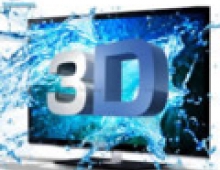
Video technology moves to a new level
3-D screens have finally arrived on the scene and they are quite good, according to an expert. Plus they are expensive.
Three-dimensional movies at home, without the silly glasses, have been a science-fiction dream for at least as long as Dick Tracy's wristwatch cell phone and the household robot.
Well, the wrist-phones and the robots already have arrived and, lo and behold, the 3-D monitor is knocking at the door. It's a flat-panel monitor from Sharp that looks like any other LCD screen until you hit a button and watch the image deepen into the screen.
The monitor isn't cheap and it isn't very practical, but engineers, architects and other professionals who work with 3-D imaging may be able to justify its $1,499 price tag. And its "wow factor" will tempt computer and movie enthusiasts.
Sharp started selling a $2,999 laptop late last year with the same 15-inch screen. But now there's a remarkable piece of software that enhances its capabilities so that any old DVD is converted into a 3-D movie.
You'd think this impossible, given that regular movies aren't recorded with the two-eyed cameras used to make such true 3-D movies as "House of Wax" and "Dial M for Murder."
Chris Yewdall at DDD Group, which developed the $99 software, says it works by looking at the colors of the scene (for instance, blue color high in the frame is probably the sky) and how the scene changes with motion to figure out how to add the missing dimension.
The effect isn't completely believable in all scenes. Distant shots are sometimes treated as if they're close, giving the impression that you're looking into a doll house.
Nonetheless, the 3-D DVD software is startling. It's an open question whether it will add anything to the enjoyment of movies in the long term, but if I had the time, I might watch all my DVDs over again just to see what they're like in 3-D.
DDD is working on putting the software into chips, which raises the possibility of flat-panel TVs that turn 3-D at the push of a button.
As for the Sharp monitor I tested, it should be noted that turning on the screen's 3-D effect -- with or without the DDD software -- comes at a price. It makes the image darker and muddier, and each eye may see a slightly distracting ghost of the image meant for the other eye.
There is also a faint overlay of vertical lines on the screen. This is because Sharp's technology adds a layer between the image-forming liquid-crystal layer and the backlight. This middle layer is transparent when the 3-D effect is off.
When the user pushes the "3-D" button, the layer turns into a fine pattern of alternating black and white vertical bars. The black bars block the light from the backlight at some angles, meaning the screen can present different images to the right and left eyes.
The principle is not unlike the one used in 3-D postcards, the kind that use a thick, ribbed plastic layer over the image to show different images to the eyes. But by cleverly putting the 3-D controlling layer behind the image, Sharp has created a much more realistic effect. The ability to turn the effect off is pretty crucial -- legibility of plain text suffers quite a bit when 3-D is on.
Also, it's 3-D, but only from one vantage point.
If it's showing someone's face, don't expect to be able to turn the screen 90 degrees and get a good look at the actor's ears. In fact, you have to position your head pretty carefully in front of the screen for the best 3-D effect.
Sharp is only selling the monitor online, which is something of a pity since the technology has to be seen to be believed. I think it would cause quite a pileup at CompUSA.
However, the monitor isn't really a consumer product. The name -- LL-151-3D -- is the first giveaway. Secondly, there's the price, and thirdly, setup is quite elaborate.
Besides professionals who work in 3-D, Sharp is hoping to gain an inroad among deep-pocketed gamers, since the screen can show most games that simulate a 3-D environment in actual 3-D if used with an nVidia GeForce graphics card.
But the screen actually adds little to games, chiefly because human depth perception is only effective up to about 18 feet. In most popular shooting games, the action takes place farther away, so the 3-D effect is not very noticeable.
Also, the frantic movement of many games gives even a 2-D screen the illusion of depth. The 3-D screen would need a slow game with up-close action to come into its own. "Tony Hawk Pro Knitting," anyone?
From Associated Press/DailyBreeze





















